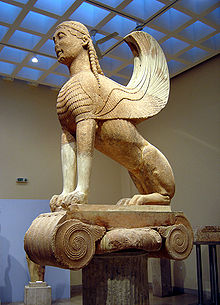Sphinx of the Naxians
The Sphinx of the Naxians (also called Naxier Sphinx ) is the ancient statue of a sphinx , a figure from Greek mythology . It represents a being with a woman's head, the body of a lion and the wings of a bird of prey. The work, made of Naxian marble , was made around 570/60 BC. Donated by the inhabitants of the island of Naxos to the sanctuary of Apollon in Delphi .
The body of the Sphinx was discovered broken into mostly larger and conforming pieces in 1861 and has been restored. The head was found in 1893. The Sphinx was originally located on an ionic column of the capital including hosel and shaft 44 thus fluting possessed larger fragments are obtained. The structure reached a total height of over 13 meters. The actual statue is 2.22 m, up to the highest tip of the wings 2.32 m high and 1.35 m long. The head height including the base of the neck is 0.67 m, from chin to crown 0.50 m. Today the statue is in the Delphi Archaeological Museum under inventory numbers 1050 (body) and 380 (head) .
On the base of the statue there is one between 331 and 327 BC. Inscription to be dated to BC: Δελφοὶ ἀπέδωκαν | Ναξίοις τὰν προμαντηΐαν | κὰτ τὰ ἀρχαῖα. ἄρχοντος Θεολύτου, βουλεύοντος | Ἐπιγένεος . “The Delphians grant the Naxians the promanty as they have always done. During Archontats of Theolytos, under the Buleuten Epigenes. "The inscription testifies to the fact that the rights granted to Naxians to a preferred Oracle survey, the law of the so-called Promantie, were extended.
literature
- Margit Jacob-Felsh : The development of Greek statue bases and the setting up of the statues. Stiftland-Verlag, Waldsassen 1969, p. 109 No. 5.
- Werner Fuchs , Josef Floren : The Greek sculpture. Volume 1: The geometric and archaic sculpture ( handbook of archeology ). Beck, Munich 1987, ISBN 3-406-31718-9 , p. 158 and passim, plate 8,6; 9.2.
- Théophile Homolle: Fouilles de Delphes. Volume 4, Fasc. 1: Kind of primitif. Art archaïque du Péloponnèse et des îles. Fontemoing, Paris 1905, pp. 41-54 ( digitized version ).
- Willy Zschietzschmann : The Sphinx of Delphi. Attempt at an interpretation. In: News of the Giessen University Society. Volume 32, 1963, pp. 93-108 ( PDF ).
Web links
- Sphinx of the Naxians in the Arachne archaeological database
Remarks
- ↑ Entry on the website of the Greek Ministry of Sport and Culture [1]
- ^ The inscription in Wilhelm Dittenberger : Sylloge inscriptionum Graecarum. 3. Edition. Hirzel, Leipzig 1905, p. 504 f. No. 292 ( digitized version ).
